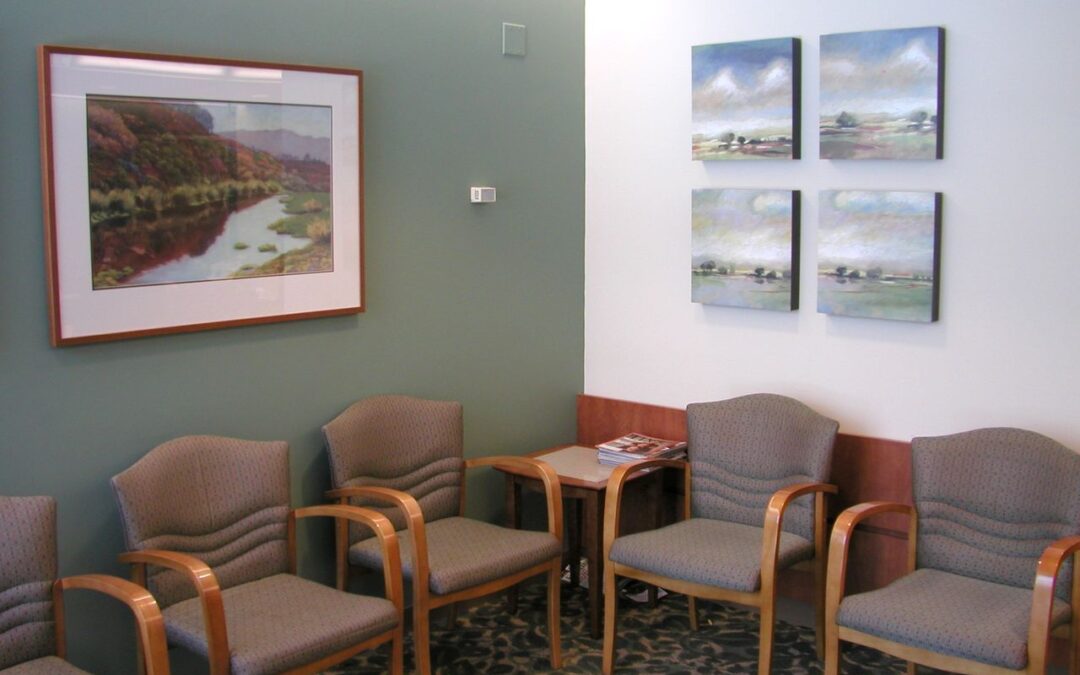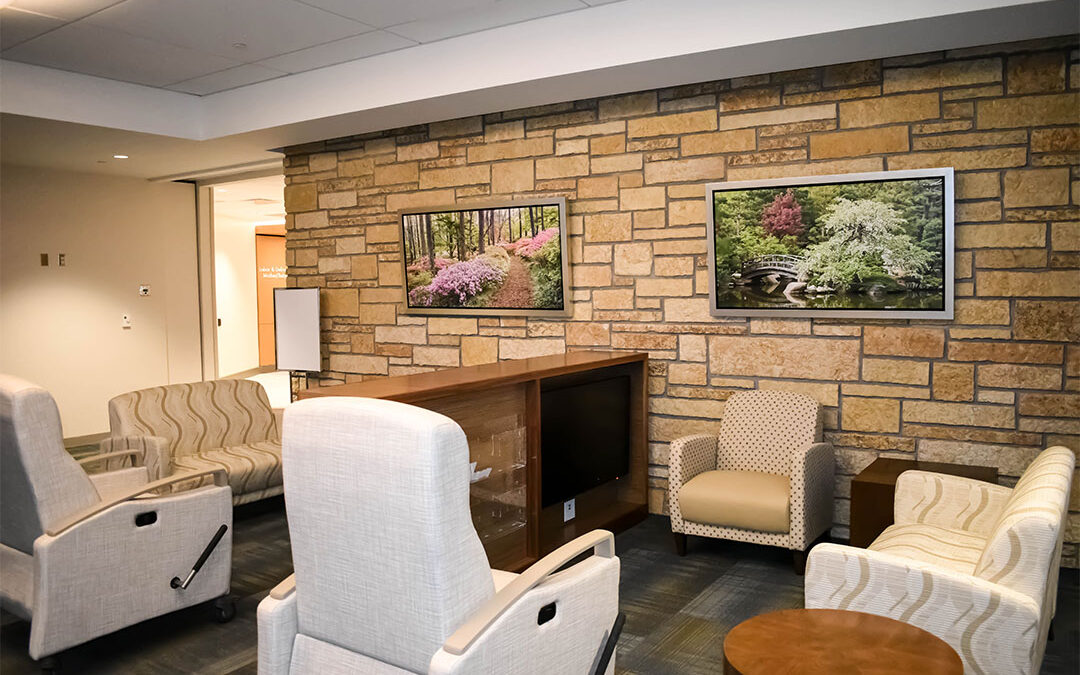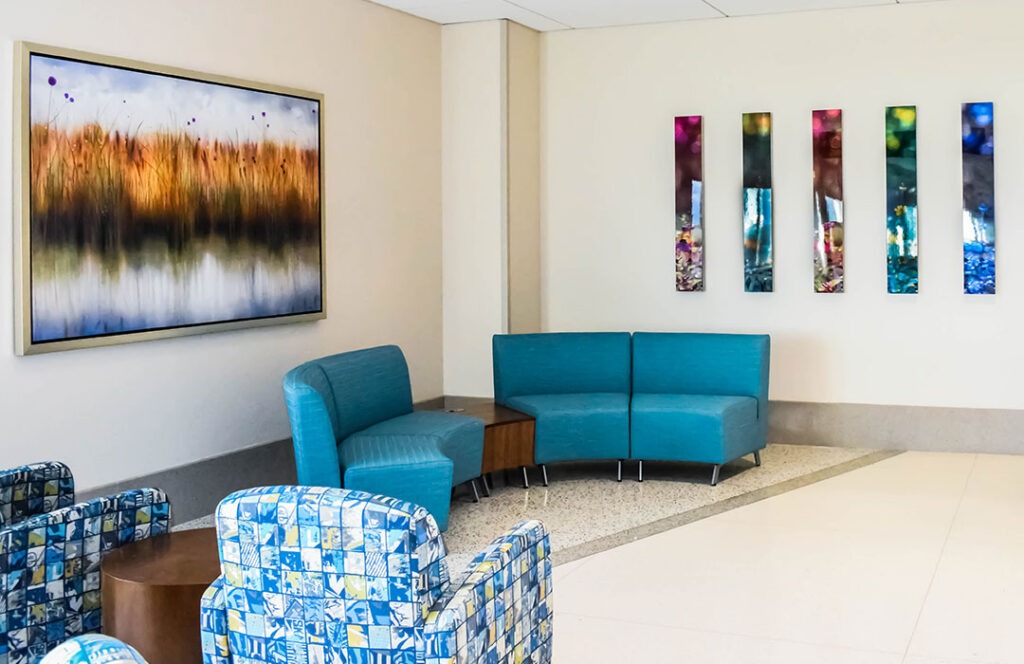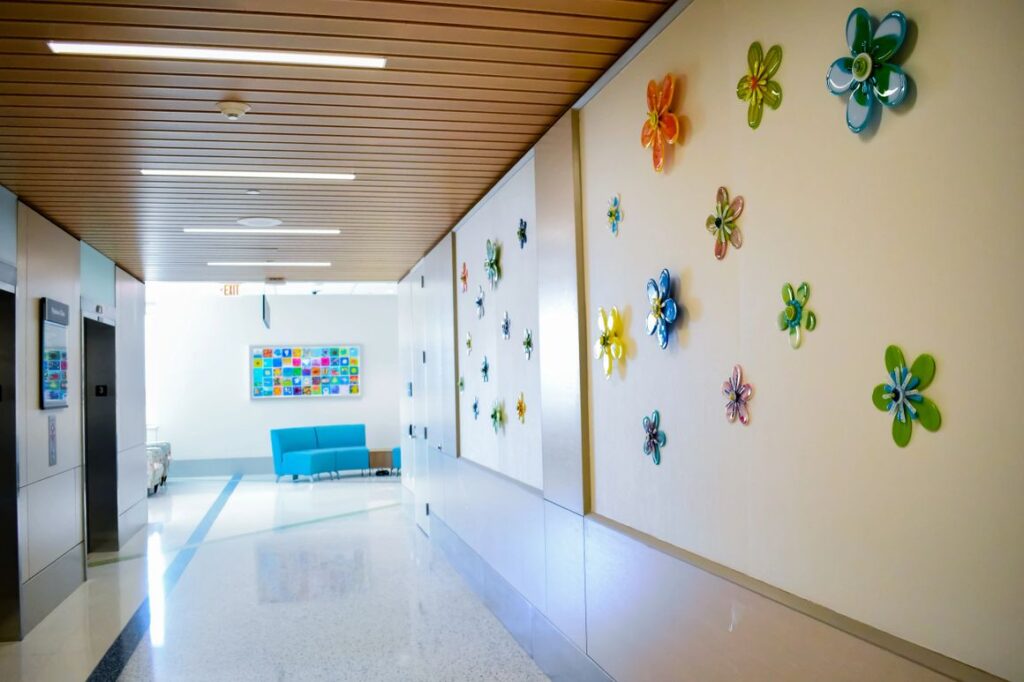
by admincat | Nov 18, 2021 | Past Projects, Throwback Thursday
Throwback Thursday! – Provena Mercy Medical Center
 Here we have a really calming healthcare project that we completed with Provena Mercy Medical Center whose name has changed to AMITA Health Mercy Medical Center Aurora over the last few years. Lots of teal going on here! Simple and clean design!
Here we have a really calming healthcare project that we completed with Provena Mercy Medical Center whose name has changed to AMITA Health Mercy Medical Center Aurora over the last few years. Lots of teal going on here! Simple and clean design!



by admincat | Nov 15, 2021 | Art Benefits, Art Consultant
No matter if it’s a hospital, a doctor’s, or a dentist’s office, children and adults alike will experience some form of stress and anxiety during their visit to a medical environment. This once seemingly normal reaction to these sorts of appointments is quickly becoming a thing of the past. And good riddance too!
Not only has evidence-based design become a growing field for hospitals, but it is also being used in smaller pediatric health and dentistry practices. Our Art Consultants at Health Environment Art Services have worked with a number of healthcare facilities of all sizes including children-specific environments. Focuses on techniques for alleviating anxiety, fear, and phobias through positive interior support design and environmental distractions.
Theming Environments & positive reinforcement
Creating a themed environment for pediatric children, both the child and their parents are immediately comfortable and put at ease; therefore reducing their anxiety and improving medical outcomes. Creating a happy experience for visitors will help instill positive reinforcement for them so they can return again without the usual type of fear and anxiety that typically accompany medical visits.
Dr. Barbara Sheller, DDR, MDS, the Chief of Pediatric Dentistry at Seattle Children’s Hospital explains that it is critical for a pediatric environment to provide warm, welcoming signals to reinforce patients and parents that they have come to the right place. The most important signals to soothe and satisfy social-emotional connections that influence childhood anxiety include bright, upbeat colors, kid-targeted activities in the waiting room, and the sincerity of staff at the practice (Sheller).

One example of a project HEAS has completed with Amita Health Alexian Brothers Women and Children’s Hospital in 2014. Commissioned through a donation from Claire’s Stores, Inc., the large-scale, kinetic sculpture in the hospital’s lobby is named “Bloom.” (See image left) The custom-designed, kid-friendly sculpture features flowerlike forms and includes a control dock at youngsters’ height to allow them to move the forms without touching them. The artists commissioned to create Bloom, Joe O’Connell, and Blessing Hancock, of Creative Machines Inc. in Tucson, Ariz., say they hope it will help young patients and visitors “find comfort and reassurance in the hospital setting.” The sculpture, they add, “celebrates the life and the impulse to enjoy it.”
Working within healthcare environments is something we take pride in. To see more children’s healthcare environments we have completed throughout the years please click here to view our portfolio.
Works Cited
Sheller, Barbara. “The Power of Positivity in Managing Pediatric Patient and Parent Behavior.” Dental Economics. N.p., 22 Mar. 2016. Web. 16 June 2016.

by admincat | Oct 11, 2021 | Art Benefits, Art Healing
Beyond Traditional Treatment: Establishing Art As Therapy
By Elaine Poggi
“Photography is the story I fail to put into words.”
— Destin Sparks
“Photography is a way of feeling, of touching, of loving. What you have caught on film is captured forever… It remembers little things, long after you have forgotten everything.”
— Aaron Siskind
I couldn’t understand why an important hospital-like Barnes Jewish Hospital in St. Louis would hang abstract art in its halls, waiting rooms, and patient rooms. I was confused by it, and so was my 85-year-old mother, who had been admitted for Non-Hodgkin’s lymphoma. I had left my family in Florence, Italy, to assist with her almost three-month stay. After the first month, I decided to take action.
I gathered from my mother’s home my enlarged photographs of nature, which I had given to her over the years. I placed them on the white walls and over the abstract art in her room. Immediately, we both felt more relaxed and comforted. The hospital staff and other patients also came to enjoy the photos. As it turned out, my photos were the last colorful images of beauty that my mother saw before passing away in the hospital.
The Foundation for Photo/Art in Hospitals an American nonprofit organization is participating in an Italian research project titled “Beyond traditional treatment… Art as therapy,” promoted by the Italian Oncological Group of Clinical Research (Il Gruppo Oncologico Italiano di Ricerca Clinica [GOIRC]), and sponsored by Eli Lilly Italia. It is being coordinated by a Florentine research group, consisting of myself; Francesco Di Costanzo, MD, Director of the Oncology Department, Massimo Rosselli, MD, Director of Psycho-oncology, and Laura Bellotti and Roberta Perfetto, psychologists at Careggi Hospital in Florence; and Franco Pasti, Professor of Architecture at the University of Florence.

The purpose of this study—the first of its kind in Italy—is to appraise cancer patients’ perceptions of the hospital environment before and after the placement of 30 nature photographs in their treatment area. The photos, donated by the Foundation for Photo/Art in Hospitals, are images of landscapes, Tuscan hillsides, marine life, tropical beaches, flowers, and animals. The supposition is that the viewing of nature photography can have a positive impact on patients.
The first phase of the research was the construction and validation of “The Test of Perception of the Hospital Environment,” created expressly for this research. The test is a 23-item questionnaire, with reference to five images of hospital rooms, with and without art displayed on the walls; six nature images; and six abstract images. To analyze the test’s validity and reliability, the pilot questionnaire was administered to 120 patients at Careggi Hospital—60 experimental cancer patients and 60 internal medicine controls. The first exploratory phase, which took over a year to complete, has confirmed the initial supposition that naturalistic images can have a positive impact on patients.
The second phase of the research is currently underway. This consists of testing 600 cancer patients from five cancer centers throughout Italy—Ancona, La Spezia, Messina, Perugia, and Terni—while they are receiving treatment; half will be the control group. In addition to the newly constructed questionnaire, three other psychological tests will be administered: SF-36 (Health Survey Questionnaire), TCI-R (Temperament and Character Inventory), and HADS (Hospital Anxiety and Depression Scale).
An abstract of the research has been accepted for presentation at the IPOS 8th World Congress of Psycho-Oncology in Venice, Italy, October 18-21, 2006, and will be published in the Journal of Psycho-Oncology.
In Italy, there was once a relationship between hospital structures and visual arts occurring throughout the history of great hospital institutions of the Renaissance, such as Santa Maria Nuova in Florence, Santa Maria Della Scala in Siena, the hospital of Ceppo in Pistoia, and San Carlo in Milan. Works of art have been placed mainly in the sacred spaces of the hospitals. Always there was a sense of collaboration between architects and artists, and the value of art as a cure was recognized implicitly.
Today, unfortunately, most Italian hospitals reflect a lack of attention to art. They tend to be cold, sterile, and impersonal. Hospital budgets do not include funding for art. In this context, our research has been very well received by the staff and patients of the five cancer centers.
When the Foundation was created four years ago, most of our photo projects were in the United States and Italy. Since then, there has been a great expansion to hospitals in other areas of the world, including Haiti, Malawi, Kenya, Poland, Japan, the Maldives, Switzerland, Brazil, and Canada. From my interactions with physicians, nurses, and administrators, I’ve found that although the physical structures and designs of the hospitals vary, the people are the same. The patients are seeking relief from their illnesses and the staff is seeking to provide such relief. It is my belief, which we are now attempting to document, that nature photography can contribute to that effort.
As the Chief Operating Officer of the Hospital Albert Schweitzer in Haiti said, “Whether it be the proud mothers of newborns, malnourished children, or patients of all ages recuperating from accidents or being treated for AIDS or tuberculosis, I know that viewing these photos cannot help but lift their spirits and give them a few moments away from their pain and suffering. If that is the case, then they will have been provided a good dose of ‘medicine’ that even the best trained doctor would not be able to provide.” HD
Elaine Poggi, originally from Southern Illinois, moved to Florence, Italy, after college to pursue studies in classical piano. After giving concerts throughout the United States and Italy for several years, she married and began a family in Florence and took up nature photography.
Photography is a very popular medium that we work with at Health Environment Art Services. Whatever our client’s vision whether it’s a mix of photography, paintings by local artists, or prints we are dedicated to fulfilling those exact needs. Please visit our portfolio to see a vast majority of the projects we have completed with hospitals across the country. Contact us today if you have a current project you are seeking help with.

by admincat | Oct 7, 2021 | Past Projects, Throwback Thursday
Throwback Thursday! – Huntley Dental in 2007
Out from our archives are some images from a project we completed with Huntley Dental in 2007! It’s crazy when you realize 2007 was more than 15 years ago!!




by admincat | Sep 30, 2021 | Artwork in Healthcare Settings
Art in Healthcare
You assess need and find that, indeed, there is one. You review and analyze financials, and consult with colleagues, subject matter experts, and close advisors. You take time to examine options, to compare and contrast pros and cons. And after such thoughtful consideration, after you’ve determined that all evidence points to a choice that is proven to be reliable—one that has a strong and measurable impact—you act.
You purchase the Burberry suit. It just hangs better. The material by itself is a wondrous experience. The mirror is your best friend. You feel really good in it. Of course, now you require accessories: shoes, a belt, a shirt or blouse, a tie or scarf, perhaps a pair of socks or some hosiery. You breeze into Wal-Mart, purchase them on clearance, in and out in 15 minutes.
What is wrong with this picture? And, what does it have to do with art in healthcare? As beautifully designed healthcare facilities are built new or expanded, art is generally lumped in with furniture, fixtures, and equipment. This is the end of the building cycle. Because of this, art is frequently given little forethought and is consequently reduced to a package of ubiquitous budget prints that conform to guiding principles that are, in practice, more form than substance.
Art is arguably the first thing people react to when they approach or enter a facility.
When the process for selecting and integrating art with healthcare design fully considers context, art adds value well beyond a visually aesthetic appeal.

Leaving the consideration of art until after the design is complete and construction is nearing final touches is much like buying a fine suit and adorning it with cheap accessories. The potential impact of the accessories is lost, and the quality of the fine suit is diminished.
Today, healthcare design is increasingly guided by evidence-based design. The goal is to inform a comprehensive design approach to create a healing environment. Patterns of movement, exposure to natural light, inside-out views of natural settings, accommodations for patients and their families, colors, textures, technology, electronic media, art, and more, all play a role.
In this environment, elements of design each earn their way and contribute to a sense of place that fosters confidence, comfort, and healing, and, as such, become important allies to healthcare providers.

There is also a clear trend toward hospitality-influenced design in healthcare. The sterile, institutional atmosphere of previous generations of medical facilities is now understood to be counterproductive in many ways. Twenty-first-century consumers of medical services know and expect more. The evidence-based design addresses the full human experience, the psychological, intellectual, and physical response to a space and to the activities that occur in the space.
The benefit of art in healthcare is in the experience of the art. While it may be dismissed by some as mere decoration, decades of research in Europe and the United States conclude otherwise. The role art plays in an overall strategy to produce healing environments has been measured against health and economic outcomes. They include:
- Clinical outcomes, such as length of hospital stay, intake of pain medication, or biological markers like blood pressure and heart rate;
- Patient-, family-, and employee-based outcomes, such as patients’ rate levels of perceived pain, satisfaction with healthcare services or working conditions, etc.; and
- Economic outcomes related to the cost of patient care, cost of employee turnover, etc.
Art is a positive distraction, directly or indirectly, in a variety of situations. It has been shown in a growing body of research to measurably reduce:
- Patient and employee anxiety and stress;
- Pain perception as measured by physiological outcomes, such as blood pressure, heart rate, and skin conductivity response, in addition to self-report measures like pain-rating scales and surveys;
- The need for analgesic medication;
- Depression associated with chemotherapy, dialysis, and other invasive treatments;
- Non-operative treatment times;
- Operative recovery times;
- Mental healthcare treatment times;
- Abusive behaviors by mental healthcare patients;
- Length of hospital stay; and
- Employee turnover, missed days;
It also measurably increases:
- Patient and employee satisfaction;
- Patient, visitor, and employee perception of quality of care; and
- Brand recognition.
 Another measure of the effectiveness of a particular selection of art is its ability to maintain interest; it is an art that doesn’t run out, doesn’t become invisible and irrelevant. Art, when appropriately selected and placed, has durability. It engages the viewers, transports them, delights and amuses them, calms and reassures them, day after day.
Another measure of the effectiveness of a particular selection of art is its ability to maintain interest; it is an art that doesn’t run out, doesn’t become invisible and irrelevant. Art, when appropriately selected and placed, has durability. It engages the viewers, transports them, delights and amuses them, calms and reassures them, day after day.
So, what does it mean to “appropriately select and place art?” The context must drive the design conversation.
Healthcare facilities can be specialized or can house a variety of treatment centers. Though there may be similarities, art that is appropriate for pediatrics will not necessarily be appropriate for oncology. Art for assisted-living centers may differ dramatically from memory care centers. And, with a focus on impression management and wayfinding, the process for selecting and placing art in lobbies, waiting rooms, and the labyrinth of hallways, also varies.
Demographics and local traditions, too, influence selections; for instance, which ethnic groups reside in the communities a facility serves and how is local culture expressed?
The value of art as a positive contributor to employee and customer satisfaction, wayfinding, and, most importantly, healthcare outcomes, varies directly with the integrity of the process used to select and place it.
Art is most effective when approached contextually with a thorough understanding of community, organizational culture, and operations, and through a collaborative design process with building, interior, and landscape architecture.
Finally, art that makes a difference does require an investment. A rule of thumb for budgeting turn-key art services is 1-2% of the construction budget; a small percentage of cost when measured against overall contribution.
Budgets in this range allow for art plans that align and integrate with organizational mission and the intentions of structural and operational design. A thoughtful art program, one with the intention to create a preferred experience, can raise the bar from beautiful, efficient, and effective to extraordinarily beautiful, efficient, and effective.
By Michael Lehman December 1, 2011
https://www.healthcaredesignmagazine.com/trends/architecture/art-healthcare/


 Here we have a really calming healthcare project that we completed with Provena Mercy Medical Center whose name has changed to AMITA Health Mercy Medical Center Aurora over the last few years. Lots of teal going on here! Simple and clean design!
Here we have a really calming healthcare project that we completed with Provena Mercy Medical Center whose name has changed to AMITA Health Mercy Medical Center Aurora over the last few years. Lots of teal going on here! Simple and clean design!













 Another measure of the effectiveness of a particular selection of art is its ability to maintain interest; it is an art that doesn’t run out, doesn’t become invisible and irrelevant. Art, when appropriately selected and placed, has durability. It engages the viewers, transports them, delights and amuses them, calms and reassures them, day after day.
Another measure of the effectiveness of a particular selection of art is its ability to maintain interest; it is an art that doesn’t run out, doesn’t become invisible and irrelevant. Art, when appropriately selected and placed, has durability. It engages the viewers, transports them, delights and amuses them, calms and reassures them, day after day.